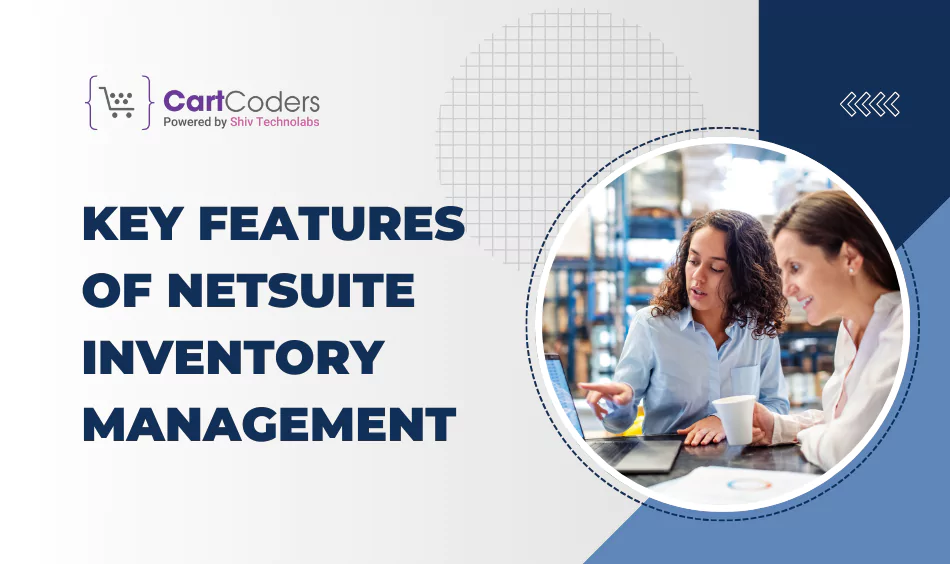Custom Engagement Solutions
Unlock tailored solutions with a free, no-obligation strategy session.
Expert Developers & Engineers on Demand
Scale Your Team with Skilled IT Professionals
Expert Guidance for Digital Transformation

Inventory management can get difficult when you’re dealing with multiple sales channels, suppliers, and warehouses.
If you sell on an eCommerce store, you already know how important it is to keep track of stock in real time. That’s where tools like NetSuite come into play.
NetSuite provides the convenience of managing product stock, warehouse activity, and order flow for eCommerce businesses—all in one place.
We have discussed what NetSuite inventory management is, how it works, and how it connects with giant eCommerce platforms like Shopify.
NetSuite inventory management is a part of the larger NetSuite ERP system. It helps businesses track what products they have, where those products are located, and how they are moving in and out of the system.
This feature is not just for counting items in a warehouse. It also helps with:
For startups as well as well-established businesses, manual inventory tracking often leads to mistakes.
With NetSuite, the goal is to make inventory control more accurate and less time-consuming.
Before exploring NetSuite, it’s important to understand why proper inventory management is critical:

NetSuite’s system supports a wide range of inventory-related tasks. Here are a few important ones:
As products are sold or returned, NetSuite updates inventory levels instantly. You always have a clear picture of what’s available.
If your products are stored across different warehouses or stores, NetSuite helps you keep track of each location’s stock.
You can set minimum quantity levels for each item. When stock drops below that point, the system can create purchase orders automatically.
This is useful for industries like food, electronics, or pharma, where tracking individual batches or items is needed for safety and compliance.
Instead of stopping your entire operation for a full inventory count, NetSuite supports cycle counting—a method of counting portions of inventory regularly to maintain accuracy.
NetSuite helps businesses track every product from the time it enters the warehouse until it reaches the customer.
Let’s look at how NetSuite handles inventory tasks step by step, in a way that supports both online and offline sales.
The first and foremost step is to enter all your products into NetSuite.
This includes SKUs, categories, pricing, weight, supplier information, and assigned warehouse locations.
You can also define storage bins, default reorder points, and preferred vendors for each item. This setup makes it easier to track and manage stock at a detailed level.
When a shipment arrives from your supplier, it is recorded in NetSuite through a purchase order.
You mark the goods as received, and the system automatically adds the items to your inventory.
If you receive stock in multiple parts, NetSuite supports partial receiving as well, so you can manage backorders properly.
As inventory is transferred between warehouses or sold through different channels (e.g., Shopify, Amazon, or physical stores), NetSuite updates stock counts in real time.
It tracks which warehouse the item is in and shows availability per location. This is especially useful for multi-location retail and global fulfillment models.
When a sale happens—say, on your Shopify store—the order flows into NetSuite. The system reserves the sold items and removes them from the available inventory once the order is fulfilled.
If you’ve connected your store using Shopify NetSuite integration services, this process happens automatically with no need for manual updates.
NetSuite can track minimum stock levels and send you an alert or reminder when it’s time to reorder.
It is simple to automate this process and to generate a purchase order once inventory drops below a set limit. It helps you to avoid last-minute stockouts and makes it easy to keep fast-moving items in stock year-round.
Returned items or damaged goods are logged back into the system. You can decide if you want to restock them, discard them, or send them back to the vendor.
NetSuite manages these records with utmost perfection and makes the adjustments, helping you keep inventory counts accurate.
NetSuite provides detailed inventory reports such as inventory valuation, aging reports, stock status by location, and sales trends.
These make it easy for you to understand which items move quickly, which ones stay on shelves, and what to stock more of during peak seasons.

If you run a store on Shopify, you already understand how important it is to have accurate inventory. That’s why many businesses consider hiring Shopify NetSuite integration solution providers.
This integration helps you:
This connection removes the need for manual updates and helps keep your Shopify store up to date.
It’s especially helpful for stores that sell through multiple channels as well, such as Amazon, offline stores, or wholesale.
Inventory is one of the biggest areas where mistakes can hurt a business, whether it’s selling items you don’t have or holding too much of what you can’t sell.
NetSuite helps solve these challenges by giving you better visibility and control. It’s not just a tool for tracking stock, but a system that supports how your entire business runs.
Here’s why many growing brands choose NetSuite for inventory management:
With NetSuite, all data—orders, inventory, and finances—is managed in one place. This gives teams better control and helps avoid double entries.
Once everything is set up, your team spends less time checking stock and more time focusing on customers or growing your store.
Automated stock updates mean fewer errors. You’re less likely to sell something you don’t have in stock.
Whether you sell on Shopify, in physical stores, or through B2B platforms, NetSuite can bring everything together. This makes it easier to manage inventory from different sources.
Many giant eCommerce brands have adopted NetSuite’s inventory management solutions to streamline their eCommerce operations. Here are some notable examples:
These examples shows how global companies belonging to different industries are using NetSuite’s inventory management feature to improve their eCommerce operations, data accuracy, and drive growth.
Must Read: ERP Integration Simplifies Inventory and Order Management
If you:
…then connecting Shopify to NetSuite can help fix these problems.
CartCoders make sure that Shopify and NetSuite is integrated to each other efficiently, and are utilized to their full potential. The goal is to keep stock accurate, reduce extra work, and handle customer orders smoothly.
NetSuite inventory management offers a reliable way to keep track of stock, orders, and product movement across locations. It helps you stay informed, avoid errors, and plan better.
When connected with Shopify, it becomes even more valuable by keeping your online store in sync with your backend operations.
At CartCoders, we help businesses with NetSuite inventory management and connect their Shopify store with it so that they can manage everything in one place.
If you’re looking to reduce stock errors, save time, and keep your customers happy, contact CartCoders today because we are ready to help you make it work smoothly.
Projects delivered in 15+ industries.
95% retention rate, building lasting partnerships.
Serving clients across 25+ countries.
60+ pros | 10+ years of experience.